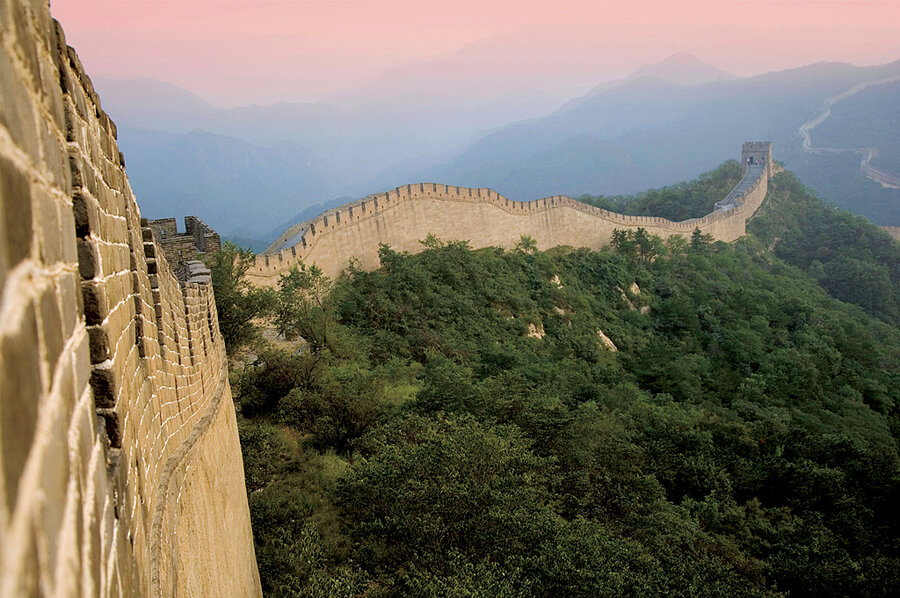China's Great Wall: A beautiful barrier
Loading...
It's a decision I had to make, and time was running out. My husband, a reporter, had been asked to move to Beijing, and the question loomed over a two-week visit I made as he was working there temporarily, but wanting to make the move. And wanting me to want to make the move.
Our plan was to mix sightseeing with an attempt to get a feel for the city and the area, meeting folks, wandering around neighborhoods, shopping, checking out local newspapers and magazines, even looking at a few apartments.
But it was the visit to the Great Wall that seemed to combine both purposes – it was an item all tourists check off the must-see list, but also to me a necessary element in understanding China. For me, geographical landmarks – whether it's the majestic Hudson River of my hometown, the Catskill Mountains surrounding my college, or the smiling fields of sun-flowers in southern France – become welcoming friends, always there, reliable and comforting.
Although we had visited a touristy part of the wall called Badaling, this time we chose something quite different: a visit to what wall-enthusiast William Lindesay calls the "Wild Wall," an unrestored segment only about 60 miles from Beijing but feeling far more distant. Mr. Lindesay organizes hiking tours from his rustic barracks, a former school that he and his Chinese wife, Qi, converted into a country inn.
The plan was to rise at 3 a.m. Armed with flashlights and warm clothes, our group of Americans, Germans, and Chinese set off in the predawn stillness. I think we woke up a local rooster at a farmhouse as we trudged up the mountainside. Even that early, the sky was beginning to show the promise of the dawn, although most of us kept our flashlights firmly aimed on the dirt path in front of us.
As we climbed, local warblers began to trill through the quietness and dogs barked in the distance. Lindesay pointed out a few murky knobs topping the hill we approached, saying they were some of the wall's thousands of watchtowers, but it was still dark enough to imagine that they could also be rock formations.
We reached a small crest about halfway up the hill and stopped. The sun had just started to paint the sky with a blend of pale peach and gold. The wall stretched out in front of us, looking as if a child had taken a fat golden crayon and traced the outline of the peaks and valleys of the mountains for miles and miles.
This was a part of the wall built during the Ming Dynasty, somewhere between AD 1400 and 1600. As Lindesay noted in our brief pauses, the wall encompasses both geography and history, with millions of laborers hauling limestone rock up mountainsides for the base, and then baking bricks in the valley and carrying them to make the top level.
"The wall is the world's largest open-air museum, but one without a curator," Lindesay told us. If anyone serves as a curator, though, it is this man who first spotted a mention of the Great Wall in his Oxford geography book when he was an 11-year-old schoolboy near Liverpool, England. His life has been on a single track since then to walk the wall, know the wall, and preserve its magnificent history.
Lindesay served as the perfect matchmaker for my introduction to this new friend. For the next 5-1/2 hours, we scrambled up segments so wild that trees grew through the center and ancient brick rubble caused us to stumble.
About midway through the hike, we came to what is known as the "ox horn," a stunning loop that snakes up one side of a mountain and down the other. We made our way to the top, slipping on sandy parts and grabbing onto the wall and saplings for support.
The top offered a panorama of craggy mountaintops in all directions and a wall that meandered along ridges as far as the eye could see, always broken up by towers that seemed to be links in a chain that girdled much of China. To the north, Mongolian invaders wanted to breach the wall and bring down dynasties.
It's interesting to think that the world's largest public works project, as Lindesay calls it, was built to keep outsiders out, when today it's the draw for the entire world – and for me. Much of Chinese thought is laden with symbolism and balance: yin and yang, male and female, the heavens and the earth. And for me, the wall – forbidding but also welcoming – became at that moment a friend I'd like to get to know better.





